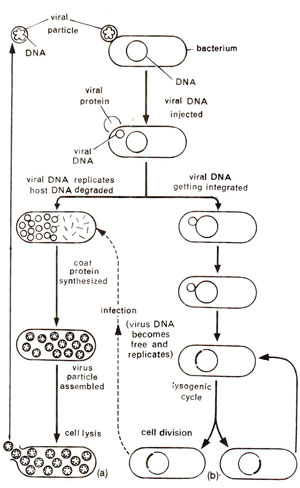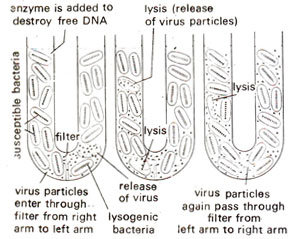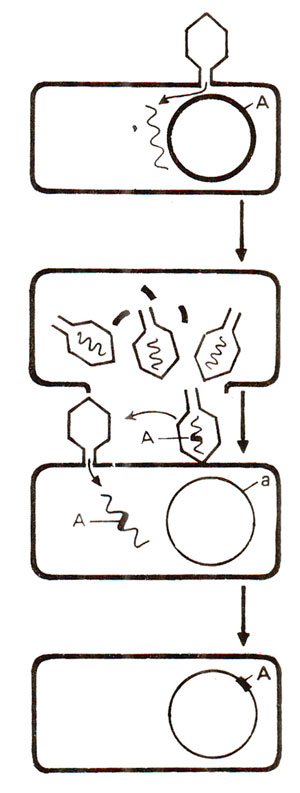The bacteriophages which cause lysis of bacterial cells (as described above) are called
'virulent' phages. There are other phages called
'temperate' phages, which may either cause lysis like virulent phages do, or may attach to bacterial chromosome thus forming its integral part (Fig. 12.19). In the latter case, phage DNA would replicate only when bacterial chromosome replicates and will stay ihere as a symbiont rather than as a parasite. In this state virus is called
'provirus', and intected bacteria are called
lysogenic, which means that the bacterial cell contains a property which can cause lysis. When lysogenic bacteria are exposed to ultraviolet light or X-rays or active chemicals like nitrogen mustard or organic peroxide, the temperate virus assumes a virulent state (Fig. 12.20).
Particles like temperate phages, which can remain in integrated as well as in free state within a cell and are dispensable elements are given the term
'episomes'. The sex factor or F factor earlier described in this section is another class of episomes.

Fig. 12.19. The life cycle of temperate phages, showing two patterns : (a) on the left is shown the virulent state and, (b) on the right is shown the lysogenic state, where the virus particle attaches to bacterial chromosome, but may become free and virulent at a later stage.

Fig. 12.20. Conversion of lysogenic state to virulent state in a temperature phage infected bacterium.

Fig. 12.19. The life cycle of temperate phages, showing two patterns : (a) on the left is shown the virulent state and, (b) on the right is shown the lysogenic state, where the virus particle attaches to bacterial chromosome, but may become free and virulent at a later stage.

Fig. 12.20. Conversion of lysogenic state to virulent state in a temperature phage infected bacterium.

Fig. 12.22. The U-tube experiment of Zinder and Lederberg showing the transfer of genetic material from one strain of bacterium to another through the agency of a bacteriophage (transduction).

Fig. 12.21. Transduction involving transfer of gene A from one strain to another through phage particle.
Transduction
When certain proviruses turn into virulent viruses thereby causing lysis of host cell, they may carry with them segments of host's DNA. If such virus particles carrying a segment of DNA from one host infects another host which is different from the first one, the latter may inherit some of the properties of the former host due to transfer of DNA segment through infecting phage (Fig. 12.21). This phenomenon of transfer of genetic material from one bacterial strain to another through the agency of virus is called transduction and was discovered in 1952 by N.D.
Zinder and J. Lederberg at the University of Wisconsin, U.S.A.

Fig. 12.22. The U-tube experiment of Zinder and Lederberg showing the transfer of genetic material from one strain of bacterium to another through the agency of a bacteriophage (transduction).
Zinder and Lederberg discovered transduction through an experiment popularly called U-tube experiment. In this experiment a U-tube was partitioned into two arms by a filter, so that only virus particles and not the bacterial cells could pass from one arm to another. One arm contained lysogenic bacteria carrying latent virus and the other arm contained bacteria susceptible to this virus. Rarely lysogenic bacteria could undergo lysis and release virus particles which crossed the filter and infected the other susceptible strain, which got destroyed releasing virus particles. These released particles carried genetic material from susceptible strain and through the filter again reached the lysogenic strain and transferred the genetic material. Since two bacterial strains could not come in contact, no conjugation was possible. An enzyme was also used which destroyed free DNA, so that the possibility of transformation was also eliminated (Fig. 12.22).

Fig. 12.21. Transduction involving transfer of gene A from one strain to another through phage particle.








